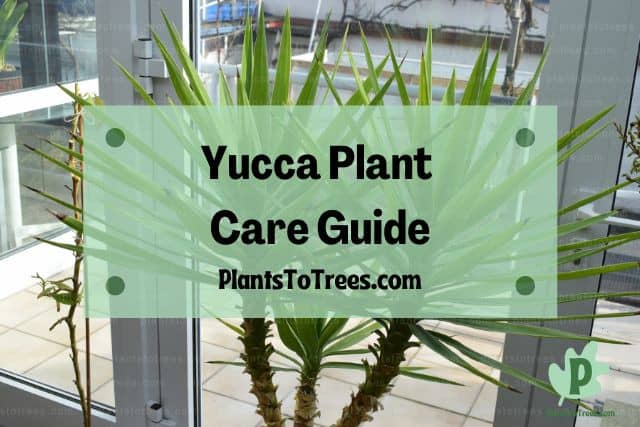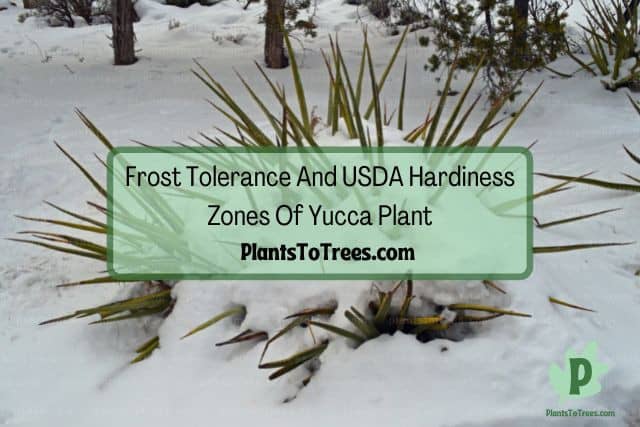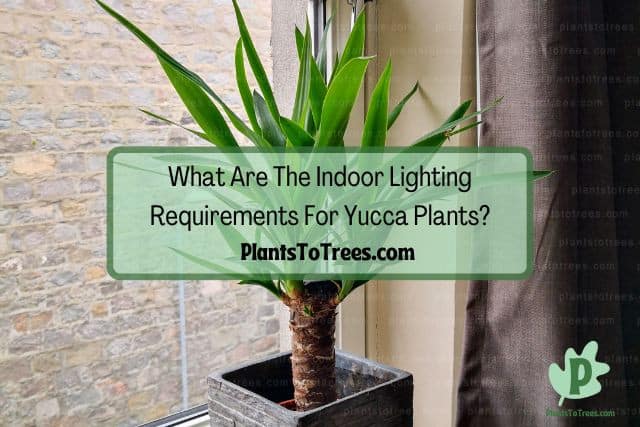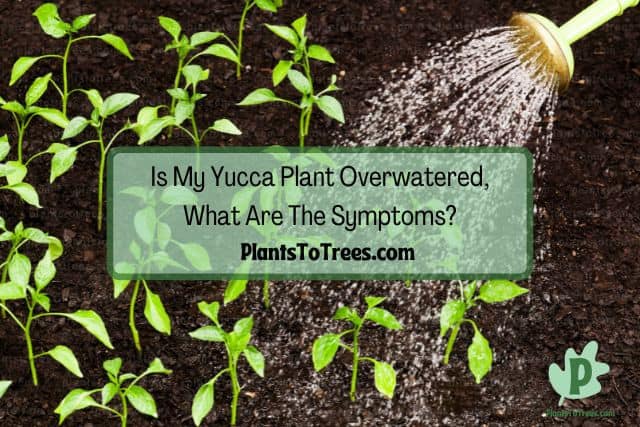Yucca plants are grown for their long, attractive foliage that can sometimes look like a sword or a blade of grass. What makes this plant even better is that it is relatively easy to grow and isn’t too fussy. Despite it being low maintenance, the yucca plant can still bring interest and texture to a room. Before you try to grow this plant, however, read over a yucca plant care guide to better understand this plant and its growing requirements.

A yucca plant care guide helps to ensure you are giving the plant the best chance of survival. This requires growing it in the optimal soil and under the right lighting. You will also need to learn the disease the plant is prone to.
There are a wide array of different yucca plants available, with some being cold hardy and able to tolerate frost, while others need warm temperatures throughout the entire year. Your climate, as well as how you want to grow the plant, will dictate which variety you can successfully grow. No matter which one you decide on, however, giving the plant its optimal growing needs will increase the chance of having a healthy plant that brings you joy for years to come.
Other Names Of Yucca Plant
Yucca plants may be well known by that name but is that the only moniker that this plant goes by?
The yucca plant goes by a wide array of names, including dagger plant, needle palm, aloe yucca, Adam’s needle, narrowleaf yucca, and Spanish bayonet. These names typically refer to the foliage that the type of yucca plant has.
Frost Tolerance And USDA Hardiness Zones Of Yucca Plant

Whether or not you can grow a plant outdoors will depend on its frost tolerance and cold hardiness. Let’s look at the frost tolerance of the yucca plant and find out what zones it can grow outdoors in.
Yucca plants have various frost and cold tolerance levels, depending on the variety. While most of them grow in USDA plant hardiness zones 5 to 10, some yuccas can grow anywhere from zones 3 to 11. However, this plant cannot handle soggy soil during periods of cold weather.
How Many Hours Of Sunlight Does Yucca Plant Need?
Knowing the amount of sunlight the yucca plant needs will help prevent potential damage to its foliage while also increasing its growth rate.
Yucca plants need 3 to 6 hours of direct sunlight every day, so select a spot that fits into these requirements. Unlike a lot of other houseplants, yucca plants do not do as well with artificial light and you should try to give it natural lighting instead.
Yucca Plant Needs Direct Or Indirect Sunlight?

Direct sunlight and indirect sunlight are two completely different types of lighting that plants need. But what type do yucca plants need?
For best growth, the yucca plant will need bright, indirect light. Not providing the plant with enough sunlight will cause the foliage to become thinner and the overall growth of the plant will slow down. If, however, you give it direct sun, the leaves can start to burn and discolor.
Is Yucca Plant An Indoor Plant, Outdoor Plant Or Both?
If you want a plant that has the potential to grow both indoors and out, look no further than the yucca plant.
Yucca plants can be grown both indoors and outdoors, as long as you select a variety that grows in your climate. If you decide on a yucca plant that doesn’t grow in your USDA hardiness zone, your only option is to bring the yucca inside and grow it as a houseplant.
What Are The Indoor Lighting Requirements For Yucca Plants?

It can be difficult to give the yucca plant the right type of light when grown indoors. But that doesn’t mean you should try to recreate the plant’s native habitat when grown inside.
Indoor yucca plants need bright, indirect sunlight for at least 3 to 6 hours. A location near a sunny window can work wonderfully for this plant. Just make sure that the sun that the yucca receives is indirect, which may require diffusing the light with a sheer curtain or moving the plant further away from the window.
What Are The Outdoor Lighting Requirements For Yucca Plants?
While it may seem easier to grow the yucca plant outside, you still need to ensure the plant gets the right amount and type of sunlight.
Whether you are growing the plant indoors or outside, the yucca needs the same type of light: bright and indirect. Direct sunlight can burn or scorch the foliage, while not enough light will cause the plant’s health and growth to suffer.
What Soil Requirements Does Yucca Plant Need?

While you may assume all soil is the same, you couldn’t be further from the truth. Some soils hold in more water than others, which can make or break how healthy your yucca plant is.
When grown outdoors, the yucca plant does best when it has sandy terrain. Indoor yuccas need a potting mix that is loose and drains well. Simply mixing perlite and coarse sand into traditional potting soil creates the perfect mixture for this beloved houseplant.
How Much Water Does a Yucca Plant Need?
Water can be both a saving grace and a death sentence to a plant if you don’t know how much it needs to survive. Giving the plant too little and you will have a dry and dehydrated plant, while giving too much will result in fungal diseases.
Yucca plants don’t like their soil or roots to stay soggy, so aim to water every 10 days or so, although this can vary from one plant to the next. The best way to determine whether it needs water is to test the moisture of the top two inches of soil.
If the top two inches of soil feels moist, wait a day or two and check the soil dryness again. Don’t water the yucca plant until those top two inches of soil feels dry. Taking the time to check the soil moisture before watering will help prevent overwatering the yucca.
Is My Yucca Plant Overwatered, What Are The Symptoms?

Overwatering any plant creates an extremely problematic situation that can pose a serious and potentially deadly situation for your houseplants.
Overwatering a yucca will cause the plant to droop and wilt, with limp foliage. Blisters that look water soaked can also begin to form, and you may even notice a musty or moldy odor coming from the plant.
As the overwatering continues, the roots of the yucca will start to rot and the plant will eventually die.
Trying to save a yucca plant that has root rot is an extremely difficult task and most gardeners have to simply let the yucca go and start fresh with a new plant. Because it is so problematic, gardeners should take great care not to allow root rot to occur in the first place.
Is My Yucca Plant Underwatered, What Are The Symptoms?
Underwatering a yucca plant isn’t as harmful as overwatering since it doesn’t lead to root rot. But that doesn’t mean it won’t take a toll on the health of the plant.
We at Plants To Trees first published this article on November 3, 2022. Copyright protected.
An underwatered yucca plant typically shows symptoms associated with a dry and dehydrated plant. This includes dry, wilted leaves that may feel crisp to the touch. The leaves can also start to curl upward. The plant will also have slowed growth and the foliage can fall off the plant.
In most cases, the yucca plant will start to perk up once it gets watered. If it is severely underwatered, however, it may take weeks or even months to get the plant back to full health.
How Much Fertilizer Does Yucca Plant Need? What Kind?

While most people know that plants need fertilizer, it is not uncommon for houseplants to be overlooked when it’s time to feed.
Yucca plants are not heavy feeders but will require fertilization about every 3 months. A good general rule is to feed a slow release 19-6-12 fertilizer to the yucca every 3 months. About 2 teaspoons of this fertilizer for an 8 inch pot.
Keep in mind, however, that the size of the plant will determine how much fertilizer to give it. You should always follow the application instructions found on the bottle to reduce the chance of overfertilizing the plant.
Yucca Plant Diseases To Be Aware Of
Yucca plants are, unfortunately, susceptible to a wide array of diseases. Knowing these diseases can help you not only detect them more quickly, but to also prevent them from occurring.
The yucca plant is prone to several different diseases, though the most prominent ones are leaf spots, sclerotia, and root rot. Leaf spot can be caused by both bacteria and a fungus, while sclerotia and root rot are caused by a fungus. All of these diseases are hard to get rid of and prevention is the best course of action.
As its name suggests, leaf spot shows up as discolored spots on the foliage of infected yucca plants. These spots can vary in size and color depending on the exact bacteria or fungi, and is usually caused by watering the plant overhead and instead of at the base.
What this does is allow for bacteria and fungi to splash up on the leaves of the plant infecting it with the disease. Control can sometimes be accomplished by snipping off infected leaves and applying a fungicide or bactericide.
Sclerotia creates a fan-like white colored growth to appear on the yucca plant. This is often seen on stems near the soil surface, but can also appear anywhere on the plant. Thankfully, using a fungicide designed for sclerotia can generally control the disease.
Root rot is a serious problem that occurs due to overwatering and/or poor soil drainage. Root rot is not easy to get rid of and, in most cases, the plant will need to be destroyed.
Are There Different Types Of Yucca Plants?

There are several different types of yucca plants available, with some of them being more common than others. Each type has its own attributes that you should consider before selecting the variety to grow.
Yucca plants come in a wide array of varieties, most of which have the same or similar growing requirements. There are, however, some differences since certain yuccas are more cold hardy than others. Additionally, you can find yuccas with foliage in different shapes.
How To Propagate Yucca Plant
Propagating yucca plants is not a difficult process but does require certain steps to increase the probability that the cutting will root and become a healthy plant.
Yucca is propagated by cutting a 3 to 4 inches piece of stem from a healthy plant. The bottom leaves of the cutting are removed and then the plant is rooted in succulent and cacti potting mix or water.
The article owner is Plants To Trees dot Com and this article was first published on November 3, 2022.
Several weeks later, the yucca plant cutting should start to grow roots. Dipping the cut end of the stem into rooting hormone can help speed up the rooting process, though this step isn’t required to propagate a yucca.
Is Yucca Plant Toxic To Humans?
Adults typically don’t get the urge to nibble on their houseplants, but that doesn’t mean you shouldn’t familiarize yourself with the toxicity level of the plants you grow both indoors and out.
Yucca plants are listed as toxic to humans, and simply getting poked by one of the sharp leaves can cause irritation, pain, swelling, and sensitivity near the site that was puncture. Some yuccas are edible, though it must be cooked completely before consuming.
Red yuccas are not edible even if you cook them so never eat this type of yucca. Additionally, you should always check whether or not your varieties are edible before consuming just to be safe.
Is Yucca Plant Toxic To Dogs?
Even though many different houseplants pose a risk to your dog, you can still grow plants indoors as long as you know the toxicity of the plant and keep those potentially harmful ones out of their reach.
The yucca plant is toxic to dogs and can cause excessive drooling, vomiting, and diarrhea. The good news, however, is that it is rarely fatal or causes long term health effects unless an abundance of the plant is consumed.
If you suspect your dog has consumed the yucca, contact their veterinarian or poison control as soon as possible.
Is Yucca Plant Toxic To Cats?
Cats are curious animals that want to sniff, smack, and taste just about anything they come across. And houseplants are often in the line of sight for these nimble creatures. Unfortunately, several houseplants pose a serious threat to your cat’s health.
Yucca plants are toxic to cats, and can cause excessive drooling, dilated pupils, weakness, vomiting, and diarrhea. Just one little nibble typically won’t cause serious or lasting effects, but it can harm your cat if they consume an abundance of it.
Contact your veterinarian or poison control if your cat has consumed any part of the yucca plant. In most cases, they should be fine.
The yucca plant typically poses more of a threat to larger grazing animals, such as cows, horses, and goats, since they consume the plant more often in greater amounts.
Related Articles
How To Fix Dracaena Plant Stem Or Root Rot
PlantsToTrees.com is the owner of this article and we first published this on November 3, 2022.
